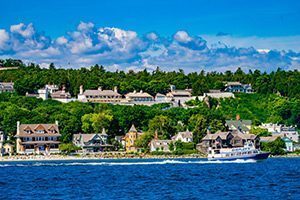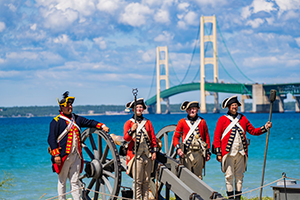This season, Mackinac State Historic Parks is celebrating the 150th anniversary of Mackinac National Park. The article below, entitled “Beautiful Mackinac,” was originally published by the Pontiac Weekly Gazette, of Pontiac, Michigan, on June 4, 1875. While visitors had already been drawn to the island’s charm for decades, that summer was monumental, as national park status had just been achieved.
Most images and the map used in this post are from John Disturnell’s travel guide, Island of Mackinac, also printed in 1875. The pocket-sized volume was especially designed for visitors to the new park. The image of the John Jacob Astor House is copied from A Lake Trip to Picturesque Mackinac. Released in 1884, the updated guide was written by C.D. Whitcomb, Passenger Agent for the Detroit and Cleveland Steam Navigation Company. The stereoview of the Island House hotel was published about 1875 as part of a “Picturesque — Mackinaw” series by Flint photographer, James A. Jenney.
____________________________
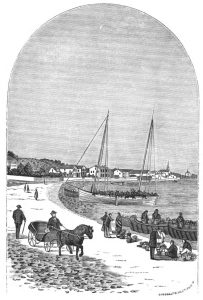

“The island of Mackinac is the most beautiful island in America, and one of the most delightful spots in the world. The scenery is strikingly beautiful, the summer temperature is all that could be desired, the air is pure and bracing, the whole island – village, forts, caves, bluffs, groves and battle fields – are rich in historic associations. It has been held successively by Indians, French, English and Americans, and the look of all four nationalities course through the veins of many of the present inhabitants. It is a rich treat to go there and mingle with the [locals] and note their characteristics and peculiarities. They are indeed a goodly people.
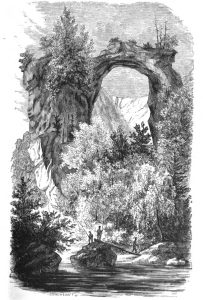

By an act of Congress approved last January, the island is to be forever set apart as a National Park, under the control of the Secretary of War. It is probable that the successive commanding officers of the Fort will be ex-officio, Superintendents of the Park. During our stay there, Major Leslie Smith, commanding the post, cut out a new serpentine road through the woods from Arched Rock to near Earley’s Red Gate. Some of the views from it toward the north shore are grand. Of course Government engineers will now lay out other roads and walks in addition to the many now existing. Mackinac is destined to be the grand National watering place of America now that the Government is taking hold of it, and here will come thousands of the sweltering sons and daughters of the south during the heated term.
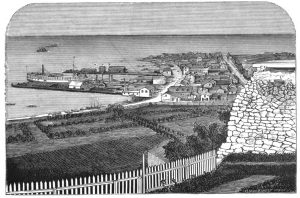

We set out to remark that instead of spending thousands of dollars to visit Europe, Long Branch, Newport and such like crowded places for health, it would be better altogether, wiser and more profitable for our people to spend a few weeks in Mackinac, where one can get real health, strength and pleasure. Persons who have once been there always long to go again. There is a charm about the life there that is hard to explain fully. To get there one can take his choice whether to go by steamer, or by rail to [Petoskey].
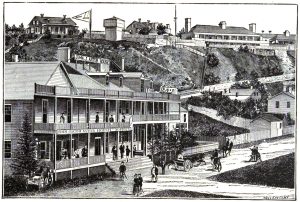

There are three large and comfortable hotels – the John Jacob Astor House, the Mission House and the Island House. The former was built by John Jacob Astor in 1823, and used as the head quarters of the American Fur Company, and many of the Astor’s old account and letter books are still there for the inspection of visitors. The Astor House is kept by Commodore James F. Cable, a splendid old fellow, full of fun and geniality, who knows how to make guests feel at home. And the Commodore is happily seconded by his wife and daughters. Seven months at the generous old Astor House, gives the writer ample occasion to speak understandingly.”
____________________________
Captain Leslie Smith commanded Fort Mackinac from 1869-1874. While his troops started work on the road from Arch Rock to Michael Early’s farm, Leslie Avenue was finished and named by his successor, Captain Greenleaf A. Goodale, in 1889. Today, the paved pathway remains one of the most scenic and peaceful routes on Mackinac Island. In all, about 70 miles of roads and trails now crisscross and encircle the island’s 2,365 acres.
In 1871, James Cable purchased a complex of structures on Market Street once owned by the American Fur Company. Linking three main buildings with a large façade, the John Jacob Astor House became the center of social life on the island until the Grand Hotel opened in 1887. The Astor House operated as a hotel until 1929, when the building was restored to individual units. Today, guests can visit one of them, the Stuart House City Museum, for a nominal fee. Other buildings now house a Community Hall and City Offices.
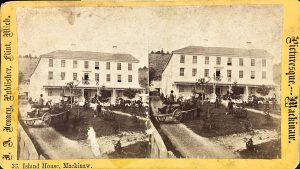

The other two hotels mentioned above, Mission House and Island House, are both still standing. Mission House was built as a Protestant mission school in 1825. It served as a public boarding house and hotel between 1845-1939. Acquired by the Mackinac Island State Park Commission in 1977, the building now serves as seasonal employee housing. The Island House is one of the oldest hotels on the island. Constructed in 1852, the structure has been moved, enlarged, enhanced, abandoned, and carefully restored over the past 173 years. Still welcoming guests today, it remains a vital link to the national park era on Mackinac Island.

